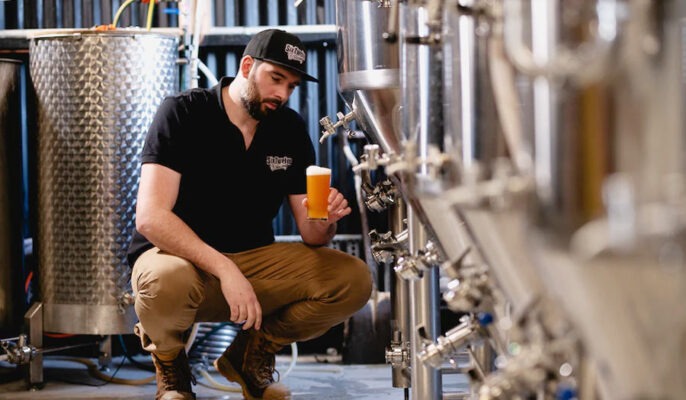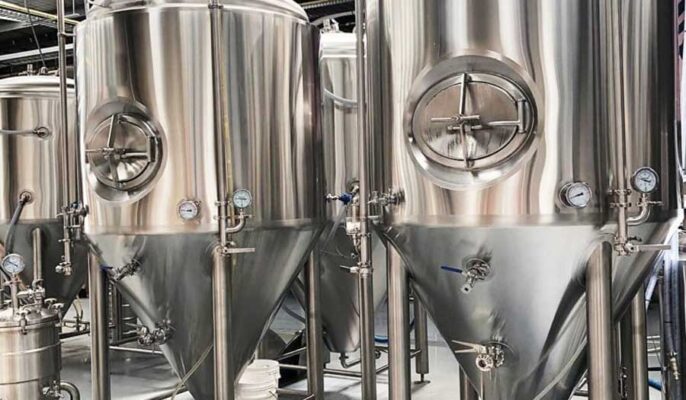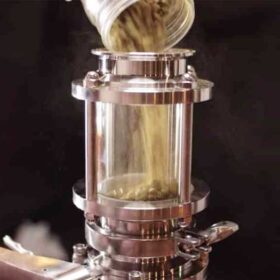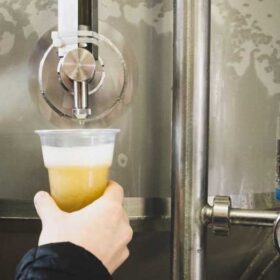독특한 풍미와 장인의 손길을 거친 맥주를 찾는 맥주 애호가들이 늘어나면서 최근 몇 년 동안 수제 맥주의 인기는 경이적으로 상승했습니다. 모든 성공적인 수제 맥주 양조장 뒤에는 끊임없이 성장하는 이 산업의 요구를 충족하도록 설계된 다양한 특수 장비가 있습니다. 이 글에서는 양조장 장비의 다양한 유형, 필수 구성 요소, 올바른 장비를 선택할 때 고려해야 할 요소 등을 살펴보며 양조장 장비의 세계에 대해 자세히 알아볼 것입니다. 이제 차가운 맥주 한 잔을 들고 다음과 같은 여정을 시작해보세요. 소규모 양조장 장비!
소규모 양조장 장비란 무엇인가요?
자세한 내용을 살펴보기 전에 소규모 양조장 장비가 무엇을 수반하는지 이해하는 것이 중요합니다. 간단히 말해, 소규모 양조장 장비는 소규모로 수제 맥주를 생산하는 데 사용되는 기계와 도구를 말합니다. 대규모 상업용 양조장과 달리 소규모 양조장은 품질과 실험에 중점을 두고 제한된 수량의 맥주를 생산하는 데 중점을 둡니다.
소규모 양조장 장비의 종류
양조장을 설립할 때 양조 과정에 필수적인 다양한 유형의 장비가 있습니다. 다음은 몇 가지 주요 유형의 양조장 장비입니다:
- 양조장 장비: 양조장은 맥주 양조 과정이 이루어지는 양조장의 핵심입니다. 일반적으로 여러 구성 요소가 포함됩니다:
- 매시 툰: 맥아 곡물을 뜨거운 물과 섞어 매싱하는 동안 당분을 추출하는 용기.
- 양조 주전자: 끓이는 주전자라고도 하며, 맥아즙을 끓이고 홉을 넣는 데 사용됩니다.
- 뜨거운 주류 탱크: 양조 과정에 사용되는 뜨거운 물을 저장합니다.
- 월풀: 끓인 후 뜨거운 찌꺼기(침전물)를 맥아즙에서 분리하는 데 사용됩니다.
- 발효 장비: 발효는 효모가 당분을 알코올로 전환하는 맥주 생산의 중요한 단계입니다. 발효 장비에는 다음이 포함됩니다:
- 발효기: 맥아즙이 발효되고 효모가 당분을 알코올과 이산화탄소로 전환하는 용기입니다.
- 브라이트 탱크: 컨디셔닝 탱크 또는 숙성 탱크라고도 하는 이 탱크는 맥주의 2차 발효 및 청징에 사용됩니다.
- 맥아즙 냉각 및 여과 장비: 끓인 후 맥아즙을 식히고 여과해야 합니다. 이 장비에는 다음이 포함됩니다:
- 플레이트 냉각기: 뜨거운 맥아즙을 빠르게 냉각하는 열교환기입니다.
- 열교환기: 뜨거운 맥아즙에서 차가운 물로 열을 전달하는 장치입니다.
- 여과 시스템: 고형물, 침전물, 안개를 제거하여 맥주를 맑게 하는 데 사용됩니다.
- 저장 장비: 셀러링 장비는 발효 후 맥주를 컨디셔닝하고 숙성시키는 데 사용됩니다. 여기에는 다음이 포함됩니다:
- 숙성 탱크: 원하는 맛과 향을 내기 위해 맥주를 특정 기간 동안 숙성시키는 용기입니다.
- 배럴: 배럴 숙성 맥주에 사용되며, 나무에서 나오는 독특한 풍미를 선사합니다.
- 케깅 시스템: 맥주 통에 맥주를 담아 유통 또는 서빙을 준비하기 위한 장비입니다.
- 포장 장비: 포장 장비는 맥주를 병에 담거나 통조림으로 만들어 유통할 준비를 하는 데 사용됩니다. 여기에는 다음이 포함됩니다:
- 보틀링 기계: 병을 채우고 뚜껑을 닫는 자동화된 시스템입니다.
- 통조림 라인: 캔을 채우고, 밀봉하고, 라벨을 붙이기 위한 장비입니다.
- 라벨링 시스템: 병이나 캔에 라벨을 부착하는 기계입니다.
- 제어 시스템: 소규모 양조장에서는 온도, 압력, 타이밍 등 양조 과정의 다양한 파라미터를 모니터링하고 제어하기 위해 제어 시스템을 활용하는 경우가 많습니다. 이러한 시스템은 맥주 생산의 일관성과 정밀성을 보장합니다.
- 청소 및 소독 장비: 양조 산업에서는 청결과 위생을 유지하는 것이 매우 중요합니다. 다음을 포함한 세척 및 살균 장비 클린인플레이스(CIP) 시스템으로 오염 물질을 제거하고 추출 장비의 위생 상태를 유지하는 데 도움이 됩니다.
다음은 양조업자가 고품질 수제 맥주를 생산하기 위해 사용하는 주요 유형의 소규모 양조장 장비입니다. 각 장비 유형은 양조 과정에서 특정 용도로 사용되며, 양조장의 생산 능력과 특정 양조 요구 사항에 따라 선택이 달라집니다.

소규모 양조장 장비의 필수 구성 요소
소규모 양조장 장비는 양조 과정과 양조장의 전반적인 기능에 기여하는 다양한 필수 구성 요소로 이루어져 있습니다. 이러한 구성 요소는 고품질의 수제 맥주를 효율적으로 생산하기 위해 함께 작동합니다. 다음은 소규모 양조장 장비에 포함된 주요 필수 구성 요소입니다:
- 제어 시스템: 제어 시스템은 브루잉 프로세스 전반에 걸쳐 다양한 파라미터를 조절하고 모니터링하는 중요한 구성 요소입니다. 여기에는 브루어가 온도, 압력, 타이밍 및 기타 중요한 변수를 관리하고 조정할 수 있는 센서, 프로브, 컨트롤러 및 소프트웨어가 포함됩니다. 이 제어 시스템은 브루잉 프로세스의 일관성과 정밀성을 보장합니다.
- 펌프: 펌프는 양조 시스템 내에서 액체를 이동하는 데 중요한 역할을 합니다. 펌프는 맥아즙, 맥주, 세척액 및 기타 유체를 여러 용기와 장비 간에 이송하는 역할을 합니다. 펌프는 원심 펌프와 양변위 펌프 등 다양한 유형으로 제공되며, 양조 공정의 특정 요구 사항에 따라 선택이 달라집니다.
- 난방 및 냉방 시스템: 가열 및 냉각 시스템은 추출 과정의 여러 단계에서 정확한 온도 제어를 유지하는 데 필수적입니다. 이러한 시스템에는 열교환기, 보일러, 냉각기, 냉각기 등이 포함됩니다. 글리콜 시스템. 이를 통해 양조자는 양조 물을 가열하고, 매싱 중 온도를 제어하고, 끓인 후 맥아즙을 식히고, 발효 온도를 원하는 범위 내에서 유지할 수 있습니다.
- 곡물 처리 장비: 곡물 취급 장비는 맥아 곡물을 효율적으로 처리하는 데 매우 중요합니다. 이 장비에는 맥아 곡물을 분쇄하여 매싱 중에 추출할 전분을 노출시키는 곡물 분쇄기와 분쇄된 곡물을 매시 툰으로 옮기는 데 도움을 주는 오거 또는 컨베이어가 포함됩니다.
- 청소 및 소독 장비: 고품질 맥주를 생산하려면 양조 장비의 청결 유지와 적절한 위생 처리가 필수적입니다. 세척 및 살균 장비에는 양조 용기와 배관을 통해 세척 용액을 순환시켜 세척 프로세스를 자동화하는 CIP(Clean-in-Place) 시스템이 포함됩니다. 이를 통해 잔류 오염 물질, 효모, 박테리아를 제거하여 위생적인 양조 조건을 보장합니다.
- 발효 용기: 발효기나 브라이트 탱크와 같은 발효 용기는 맥즙이 발효 및 컨디셔닝을 거치는 곳입니다. 이러한 용기는 일반적으로 스테인리스 스틸로 만들어지며 효모 활동과 맥주 숙성을 위한 최적의 환경을 조성하기 위해 온도 제어 시스템, 압력 릴리프 밸브 및 위생 피팅이 장착되어 있는 경우가 많습니다.
- 패키징 구성 요소: 포장 구성 요소는 완성된 맥주를 포장하고 유통하는 데 필수적입니다. 여기에는 탄산 시스템, 충전 밸브, 케그 커플러, 병 또는 캔 필러, 라벨링 시스템이 포함됩니다. 이러한 구성 요소는 맥주를 병, 캔 또는 통에 포장하는 동시에 적절한 탄산을 공급하고 제품 품질을 유지하는 데 도움이 됩니다.
- 밸브 및 피팅: 밸브와 피팅은 브루잉 시스템 내에서 액체와 가스의 흐름을 제어하는 데 매우 중요합니다. 여기에는 볼 밸브, 버터플라이 밸브, 샘플 밸브, 사이트 글라스 및 위생 피팅이 포함됩니다. 이러한 구성 요소를 통해 양조자는 용기 간 액체 이송, 유량 제어, 품질 테스트를 위한 샘플 채취 등 양조 공정의 다양한 단계에서 유체의 이동을 제어할 수 있습니다.
다음은 소규모 양조장 장비의 필수 구성 요소 중 일부입니다. 각 구성 요소는 양조 공정에서 중요한 역할을 하며 수제 맥주 생산 전반에 걸쳐 효율성, 제어 및 위생을 보장합니다. 이러한 구성 요소의 선택과 통합은 양조장의 특정 요구 사항과 규모에 따라 달라집니다.
소규모 양조장 장비 선택 시 고려해야 할 요소
소규모 양조장 장비를 선택할 때는 장비가 양조 요구 사항을 충족하고 소규모 양조장의 성공을 뒷받침할 수 있도록 몇 가지 요소를 고려해야 합니다. 다음은 고려해야 할 몇 가지 주요 요소입니다:
- 생산 능력: 소규모 양조장의 원하는 생산 능력을 결정합니다. 배치 크기와 전체 연간 생산량 측면에서 생산하고자 하는 맥주의 양을 고려하세요. 예상 생산량을 효과적으로 처리할 수 있는 장비를 선택하세요.
- 품질과 효율성: 효율적이고 일관된 성능을 위해 설계된 고품질 장비에 투자하세요. 장인 정신과 신뢰성으로 유명한 평판이 좋은 제조업체를 찾아보세요. 효율적인 장비는 양조 공정을 최적화하고 낭비를 줄이며 전반적인 생산성을 향상하는 데 도움이 됩니다.
- 유연성 및 확장성: 장비의 유연성과 확장성을 고려합니다. 장비가 향후 성장과 확장이 가능한지 평가합니다. 생산량 증가 또는 새로운 맥주 스타일 추가를 수용할 수 있나요? 유연성과 확장성을 제공하는 장비를 선택하면 변화하는 시장 수요와 양조장의 성장에 적응할 수 있습니다.
- 공간 및 레이아웃: 양조장의 가용 공간을 평가하고 장비 배치를 고려하세요. 선택한 장비가 할당된 공간에 적합하고 효율적인 워크플로와 손쉬운 조작이 가능한지 확인하세요. 유지보수 및 청소를 위해 장비의 접근성을 고려하세요.
- 예산 및 비용 분석: 소규모 양조장 장비에 대한 현실적인 예산을 설정하세요. 초기 구매 비용뿐만 아니라 유지보수, 수리, 유틸리티 비용을 포함한 장기적인 소유 비용도 고려하세요. 철저한 비용 분석을 수행하여 재정적 영향을 파악하고 장비 투자가 예산에 맞는지 확인하세요.
- 양조 스타일과 복잡성: 생산하려는 맥주의 특정 양조 스타일과 복잡성을 고려하세요. 일부 장비는 특정 맥주 스타일이나 양조 기술에 더 적합할 수 있습니다. 선택한 장비가 원하는 맥주 프로필에 필요한 양조 과정과 기술을 지원하는지 확인하세요.
- 지원 및 서비스: 장비 제조업체 또는 공급업체가 제공하는 지원 및 서비스 수준을 평가합니다. 보증, 기술 지원, 예비 부품 가용성, 판매 후 지원과 같은 요소를 고려하세요. 신뢰할 수 있는 지원은 장비 문제나 고장 발생 시 신속한 지원을 보장합니다.
- 에너지 효율성 및 지속 가능성: 장비의 에너지 효율성과 지속 가능성 기능을 고려하세요. 에너지 효율적인 장비 는 유틸리티 비용을 절감하고 환경에 미치는 영향을 최소화하는 데 도움이 될 수 있습니다. 열 회수 시스템, 효율적인 단열, 물 절약 기술과 같은 기능이 통합된 장비를 찾아보세요.
- 규정 준수: 장비가 필요한 규제 표준을 충족하고 현지 보건 및 안전 규정을 준수하는지 확인하세요. 규정을 준수하면 운영의 안전과 맥주의 품질을 보장할 수 있습니다.
- 사용자 친화성 및 교육: 장비의 사용 편의성과 사용자 친화성을 고려하세요. 직관적이고 사용자 친화적인 장비는 양조 프로세스를 간소화하고 양조 팀의 학습 곡선을 줄여줍니다. 또한 교육 리소스 및 지원의 가용성을 평가하여 팀이 장비를 효과적으로 운영할 수 있는지 확인하세요.
소규모 양조장 설립 시 주요 고려 사항
설정 소규모 양조장 는 신중한 계획과 고려가 필요합니다. 다음은 몇 가지 주요 고려 사항입니다:
- 라이선스 및 허가: 양조장 운영에 필요한 현지 당국의 인허가 및 허가를 취득합니다. 여기에는 주류 생산, 유통 및 서빙에 대한 허가가 포함될 수 있습니다.
- 위치 및 공간: 접근성, 지역 규제, 목표 시장과의 근접성 등의 요소를 고려하여 소규모 양조장에 적합한 위치를 선택하세요. 공간이 적절하게 환기되고 배수가 잘 되며 안전 기준을 충족하는지 확인합니다.
- 레시피 개발 및 실험: 수제 맥주 애호가들은 혁신과 독특한 풍미를 좋아합니다. 맥주 레시피를 개발하고 개선하는 데 시간을 투자하여 실험과 창의성을 발휘할 수 있는 여지를 마련하세요.
- 마케팅 및 브랜딩: 강력한 브랜드 아이덴티티와 마케팅 전략을 개발하여 소규모 양조장을 홍보하세요. 소셜 미디어, 온라인 플랫폼, 지역 이벤트를 활용하여 인지도를 높이고 고객을 유치하세요.
- 직원 및 교육: 수제 맥주에 대한 열정을 가진 숙련된 양조자, 저장고 작업자, 판매 직원으로 구성된 팀을 모집하세요. 이들의 지식과 기술을 향상시키기 위한 지속적인 교육을 제공하여 맥주 생산의 일관된 품질을 보장합니다.
이러한 주요 측면을 고려하면 마이크로브루어리의 탄탄한 기반을 마련하고 경쟁이 치열한 수제 맥주 시장에서 성공할 가능성을 높일 수 있습니다.
소규모 양조장 장비의 비용 분석
소규모 양조장을 시작하려면 상당한 재정적 투자가 필요합니다. 다음은 예산 계획을 세우는 데 도움이 되는 주요 장비 및 기타 비용에 대한 비용 분석입니다:
- 양조장 장비: 양조장 비용은 크기, 구성 및 추가 기능에 따라 달라질 수 있습니다. 소규모 양조장에 적합한 소규모 양조장은 $50,000에서 $200,000까지 다양합니다. 여기에는 매시 툰, 양조 주전자, 뜨거운 주류 탱크, 월풀이 포함됩니다.
- 발효 장비: 발효기와 브라이트 탱크를 포함한 발효 장비는 크기와 사양에 따라 $10,000~$50,000의 비용이 들 수 있습니다. 온도 제어 시스템에는 $5,000~$20,000의 추가 투자가 필요할 수 있습니다.
- 맥아즙 냉각 및 여과 장비: 플레이트 냉각기, 열교환기 및 여과 시스템에 투자하는 데는 약 $10,000에서 $30,000의 비용이 들 수 있습니다. 이러한 시스템은 맥주의 투명도와 품질을 유지하는 데 중요한 역할을 합니다.
- 저장 장비: 숙성 탱크, 배럴, 케깅 시스템과 같은 셀러링 장비는 $10,000에서 $50,000까지 다양합니다. 비용은 용량과 사용되는 재료에 따라 달라집니다.
- 포장 장비: 병입 기계, 통조림 라인, 라벨링 시스템, 포장 재료 등 포장 장비는 비용에 따라 크게 달라질 수 있습니다. 소규모 포장 설정은 원하는 출력 용량에 따라 $10,000에서 $50,000 이상까지 다양합니다.
장비 비용 외에도 다음과 같은 다른 비용도 고려하는 것이 중요합니다:
- 양조장 공간의 리노베이션 및 건설 비용
- 수도, 전기, 가스 등의 공공요금
- 맥아, 홉, 효모 및 부재료와 같은 원료
- 마케팅 및 광고 비용
- 라이선스 및 허가 수수료
- 양조장 및 장비에 대한 보험 적용
- 지속적인 유지 관리 및 수리

고품질 소규모 양조장 장비 사용의 이점
고품질의 양조장 장비를 사용하면 브루어와 수제 맥주 생산에 여러 가지 이점이 있습니다:
- 일관된 품질: 고품질 장비는 양조 공정의 일관성을 보장하여 일관된 풍미 프로파일과 맥주 품질을 제공합니다. 정밀한 온도 제어, 효율적인 여과, 안정적인 발효는 최종 제품의 전반적인 일관성에 기여합니다.
- 효율성 및 생산성 향상: 고품질 장비는 효율성과 생산성을 최적화하도록 설계되었습니다. 자동 제어 및 효율적인 열 전달 시스템과 같은 첨단 기술을 통해 양조업체는 운영을 간소화하고 수작업을 줄이며 품질 저하 없이 생산량을 늘릴 수 있습니다.
- 향상된 제어 및 유연성: 최고급 장비를 사용하면 온도, 압력, 유량 등 다양한 파라미터를 더 잘 제어할 수 있습니다. 이러한 수준의 제어를 통해 양조 공정을 미세 조정하고 다양한 레시피를 실험하며 원하는 맛과 향을 정밀하게 구현할 수 있습니다.
- 내구성 및 수명: 내구성이 뛰어나고 잘 만들어진 장비에 투자하면 장비의 수명이 길어지고 고장이나 수리 비용의 위험이 줄어듭니다. 고품질의 재료와 장인 정신은 장비의 신뢰성과 견고함에 기여하므로 양조자는 장비 유지보수보다는 양조에 집중할 수 있습니다.
- 안전 및 위생: 프리미엄 양조장 장비는 안전과 위생을 염두에 두고 설계되었습니다. 위생 피팅, 손쉬운 세척 접근성, 식품 등급 재료에 대한 업계 표준 준수 등의 기능이 통합되어 있습니다. 이를 통해 깨끗하고 위생적인 양조 환경을 유지하고 오염의 위험을 최소화할 수 있습니다.
고품질의 소규모 양조장 장비를 사용하여 양조업자는 자신의 기술을 향상시키고 뛰어난 맥주를 생산하며 경쟁이 치열한 수제 맥주 시장에서 장기적인 성공을 위한 탄탄한 기반을 구축할 수 있습니다.
소규모 양조장 장비의 과제와 솔루션
소규모 양조장 장비에는 여러 가지 어려움이 있습니다. 하지만 신중한 계획과 사전 조치를 통해 이러한 문제를 극복할 수 있습니다. 다음은 소규모 양조장 장비의 일반적인 문제와 잠재적인 해결책입니다:
- 비용 제약: 소규모 양조장 장비에 투자하는 것은 특히 소규모 양조장이나 신생 양조장의 경우 상당한 재정적 부담이 될 수 있습니다. 이러한 문제를 극복하기 위해 양조업체는 리스 옵션을 고려하거나 금융 파트너십을 모색하거나 품질 기준을 충족하는 중고 장비를 선택할 수 있습니다.
- 유지 관리 및 기술 전문성: 복잡한 양조 장비를 유지 관리하고 문제를 해결하려면 기술적 전문 지식이 필요합니다. 양조업체는 직원을 위한 교육 프로그램에 투자하거나 종합적인 지원 및 유지보수 서비스를 제공하는 장비 공급업체와 협력하여 이 문제를 해결할 수 있습니다. 정기적인 장비 점검과 예방적 유지보수를 통해 비용이 많이 드는 문제가 발생하기 전에 문제를 파악하고 해결할 수 있습니다.
- 품질 관리 및 일관성: 특히 소규모 양조장의 경우 여러 배치에서 일관된 품질을 유지하는 것이 어려울 수 있습니다. 엄격한 품질 관리 프로토콜을 구현하고 자동화에 투자하고 모니터링 시스템정기적으로 관능 평가를 실시하면 맛, 향 및 전반적인 맥주 품질의 일관성을 보장하는 데 도움이 될 수 있습니다. 프로세스를 표준화하고 레시피와 양조 매개변수를 문서화하는 것도 일관된 결과에 기여할 수 있습니다.
- 생산 확장: 양조장이 성장하고 수요가 증가함에 따라 품질을 유지하면서 생산량을 늘리는 것은 어려운 일이 될 수 있습니다. 양조업체는 처음부터 확장성을 고려하여 장비와 인프라가 늘어나는 물량을 처리할 수 있도록 계획해야 합니다. 경험이 풍부한 양조 컨설턴트와 협력하면 이 과정에서 귀중한 인사이트와 도움을 받을 수 있습니다.
- 규정 준수: 소규모 양조장은 허가, 라이선스, 보건 및 안전 기준, 라벨링 규정 등 다양한 규제 요건을 준수해야 합니다. 현지, 지역 및 국가 규정에 대한 정보를 파악하고 법률 및 규정 준수 전문가와 긴밀히 협력하면 규정을 준수하고 잠재적인 법적 문제를 방지하는 데 도움이 됩니다.
이러한 문제를 사전에 해결하고 적절한 솔루션을 모색함으로써 양조장 장비의 성능을 최적화하고 일관된 품질을 보장하며 경쟁이 치열한 수제 맥주 업계에서 지속 가능한 성장을 달성할 수 있습니다.







Photoshop Crack